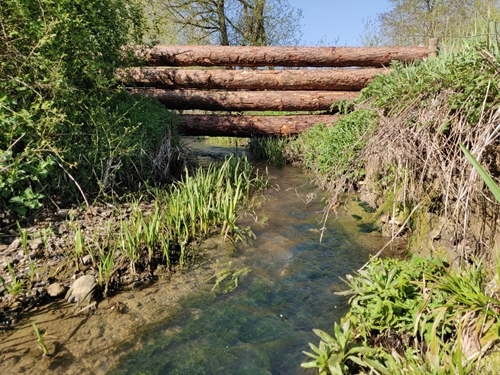There is increasing concern about flood risk associated with climate change, and an interest in means of addressing this that complement traditional flood defence measures in flood-prone areas. Since 2016, we have been installing permeable timber dams in the Eye Brook headwater within our Water Friendly Farming project. The intention has been to create low cost barriers to hold water back in ditches and small streams, without any negative consequences for farming, so as to reduce downstream risks of flooding. Most of the dams are designed to hold water back within the channel, but some are extended into small floodplains to increase the storage capacity where the land is otherwise unproductive from an agricultural perspective, or not used for access.

Initially, these dams were made with lengths of cordwood sourced from local woods that were being thinned to improve timber production or wildlife habitat. They were intended to be easily constructed by a local contractor or farmer. Although we wanted to hold water back during storm events, we did not want to impede baseflow so a gap was left at the base of the dam.
The dams worked well until the really heavy storms arrived and six of the dams on the main stream were badly damaged. As a result, we redesigned and rebuilt these larger dams so that they were made from long lengths of timber that spanned the whole channel width, without the need for joins or in-channel support posts. We selected larch to prolong the life of the dams.
We also raised the base of the dams so that they were above winter baseflow. This reduced the frequency with which water backed up behind the dams, but improved their performance during the larger events which are the ones we are most concerned about in terms of flood risk. These dams have held up well to the largest storms and the flow monitoring at the base of the catchment allows us to evaluate their performance. With our partners at the Freshwater Habitats Trust, we have produced a guidance document on the practical design and installation of permeable dams which is available as a pdf here.
York University's hydrological modelling reveals that for the most commonly occurring storm events (those occurring at up to one in a hundred-year intervals), the 28 dams across the 1,000ha catchment reduced peak flow at the base of the headwater catchment by 19-24%.
For very severe events (those occurring only once in a thousand years), the reduction in peak flow was 11%. Although encouraging, this is a reminder that we are less able to adapt to the more severe events that climate change is expected to confront us with more frequently in future. This is one of many reasons why, as well as investigating approaches to adaptation, our research is also focusing on ways in which we can mitigate climate change through the management of agricultural land.

Permeable dam outside the study area at our research and demonstration farm at Loddington